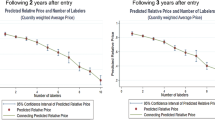Abstract
Pharmaceutical expenditures have grown rapidly in recent decades, and now total nearly 10% of health care costs. Generic drug utilization has risen substantially alongside, from 19% of scripts in 1984 to 47% in 2001, thus tempering expenditure growth through significant direct dollar savings. However, generic drugs may lead to indirect savings as well if their use reduces the average price of those brand-name drugs that are still purchased. Prior work indicates that brand-name producers do not lower their prices in the face of generic competition, and our study confirms that finding. However, prior work is silent on how the mix of consumer choices between generic and brand-name drugs might affect the average price of those brand-name drugs that are purchased. We use a nationally representative panel of data on drug utilization and costs for the years 1996–2001 to examine how the share of an individual’s prescriptions filled by generics (generic script share) affects his average out-of-pocket cost for brand-name drugs, and the net cost paid by the insurer. Our principal finding is that a higher generic script share lowers average brand-name prices to consumers, presumably because consumers are more likely to substitute generics when brand-name drugs would cost them more. This effect is substantial: a 10% increase in the consumer’s generic script share is associated with a 15.6% decline in the average price paid for brand-name drugs by consumers. This implies that the potential cost savings to consumers from generic substitution are far greater than prior work suggests. In contrast, the percentage reduction in average brand costs to health plans is far smaller, and statistically insignificant.
Similar content being viewed by others
References
Berndt E.R. (2002) Pharmaceuticals in U.S. health care: Determinants of quantity and price. The Journal of Economic Perspectives 16(4): 45–66. doi:10.1257/089533002320950975
Caves R.E., Whinston M.D., Hurwitz M.A. (1991) Patent expiration, entry, and competition in the U.S. pharmaceutical industry. In: Winston C., Baily M. (eds) Brookings Papers on Economic Activity: Microeconomics. Brookings Institution Press, Washington, DC, p 332
Center on an Aging Society. (2002). Prescription drugs: A vital component of health care. Washington, DC: Georgetown University.
Cohen, J. (1997). Sample design of the 1996 medical expenditure panel survey household component. MEPS Methodology Report No. 2 AHCPR Pub. No. 97-0027. Rockville, MD: Agency for Health Care Policy and Research.
Cohen J., Monheit A., Beauregard K. (2002) The medical expenditure panel survey: A national health information resource. Inquiry 33(4): 373–389
Congressional Budget Office. (1998). How increased competition from generic drugs has affected prices and returns in the pharmaceutical industry. Washington, DC: Congressional Budget Office.
Fisher S.E., Cockburn I.M., Griliches Z. et al (1997) Characteristics of demand for pharmaceutical products: An examination of four cephalosporins. The Rand Journal of Economics 28: 426–446. doi:10.2307/2556023
Frank R.G., Salkever D.S. (1997) Generic entry and the pricing of pharmaceuticals. Journal of Economics & Management Strategy 6: 75–90. doi:10.1162/105864097567039
Gaither C., Kirking D., Ascione F. et al (2001) Consumer’s views on generic medications. Journal of the American Pharmaceutical Association 41(5): 729–736
Ganther J.M., Kreling D.H. (2000) Consumer perceptions of risk and required cost savings for generic prescription drugs. Journal of the American Pharmaceutical Association 40: 378–383
Gaynor M., Polachek S.W. (1994) Measuring information in the market: An application to physician services. Southern Economic Journal 60(4): 815–831. doi:10.2307/1060422
Grabowski H.G., Vernon J.M. (1992) Brand loyalty, entry, and price competition in pharmaceuticals after the 1984 drug act. The Journal of Law & Economics 35: 331–350. doi:10.1086/467257
Hibbard J.H., Weeks E.C. (1987) Consumerism in health care: Prevalence and predictors. Medical Care 25(11): 1019–1032. doi:10.1097/00005650-198711000-00001
Hibbard J.H., Weeks E.C. (1989) Does the dissemination of comparative data on physician fees affect consumer use of services?. Medical Care 27(12): 1167–1174. doi:10.1097/00005650-198912000-00008
Jena, A. B., Calfee, J. E., Goldman, D., Mansley, E. C., & Philipson, T. J. (forthcoming). Me-too innovation in pharmaceutical markets. Forums for Health Economics and Policy.
Kaiser Family Foundation. (2004). Prescription drug trends. Washington, DC: Kaiser Family Foundation.
Kendall K.W., Ng S., Schoner B. (1991) Consumer response to generic/chemically equivalent drugs. Journal of Public Policy & Marketing 10: 182–201
Meier, M. H. “The FTC’s Pharmaceutical Industry Cases.” California Bar Association. (2002). Document available at: www.calbar.ca.gov/calbar/pdfs/sections/antitrust/2002-06-26_generic-drug_materials-meier.pdf.
NIHCM Foundation (National Institute for Health Care Management Research and Educational Foundation). (2002). A primer: Generic drugs, patents, and the pharmaceutical market place. Washington, DC: NICHM Foundation. Retrieved from http://www.nihcm.org/GenericsPrimer.pdf. Accessed 18 Dec 2008.
Office of Technology Assessment. (1993). Pharmaceutical R&D: Costs, risks and rewards. Washington, DC: Office of Technology Assessment.
Perri M., Wolfgang A., Janket C. (1990) Georgia consumers’ awareness and perceptions of generic drugs after the scandals. American Pharmacy NS30(10): 33–36
Pharmaceutical Research and Manufacturers of America. (2001). A century of progress. Washington, DC: Pharmaceutical Research and Manufacturers of America.
Silcock J., Ryan M., Bond C. et al (1997) The cost of medicines in the United Kingdom: A survey of general practitioners’ opinions and knowledge. PharmacoEconomics 11(1): 56–63. doi:10.2165/00019053-199711010-00007
Wiggins S.N., Maness R.S. (2004) Price competition in pharmaceuticals: The case of anti-infectives. Economic Inquiry 42(2): 247–263. doi:10.1093/ei/cbh058
Author information
Authors and Affiliations
Corresponding author
Rights and permissions
About this article
Cite this article
Rizzo, J.A., Zeckhauser, R. Generic script share and the price of brand-name drugs: the role of consumer choice. Int J Health Care Finance Econ 9, 291–316 (2009). https://doi.org/10.1007/s10754-008-9052-0
Received:
Accepted:
Published:
Issue Date:
DOI: https://doi.org/10.1007/s10754-008-9052-0




